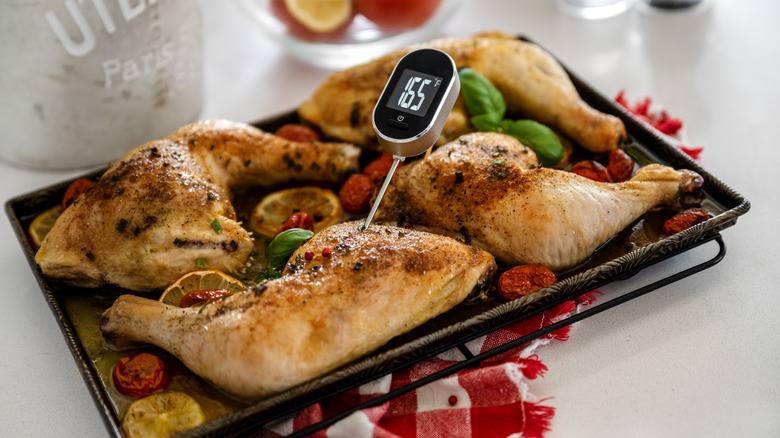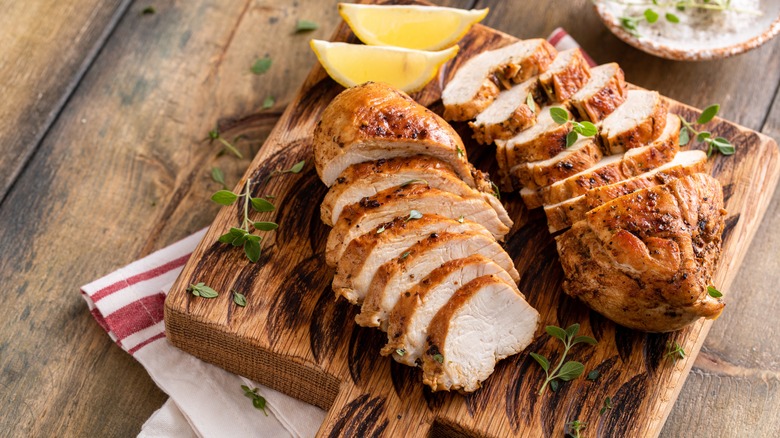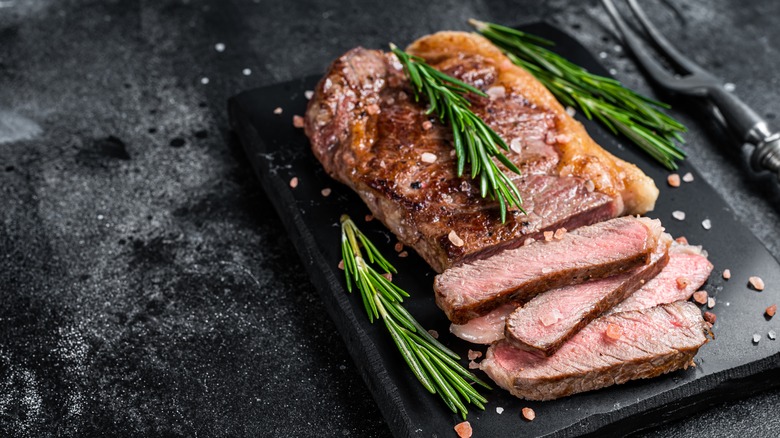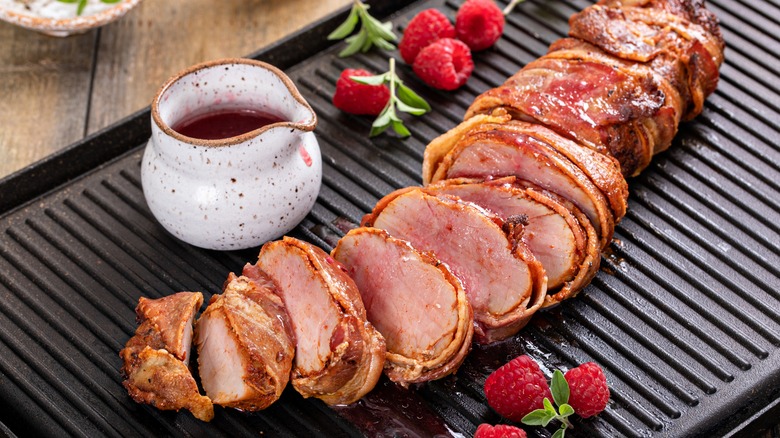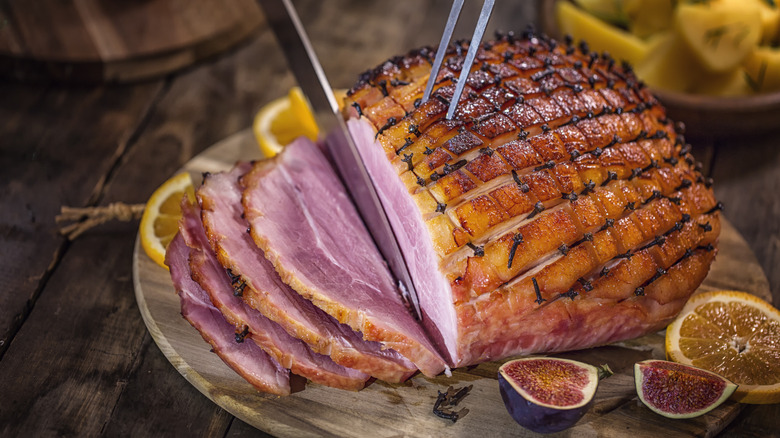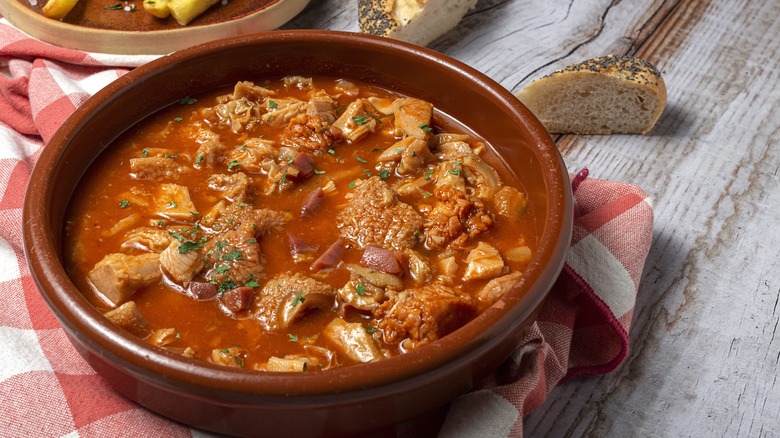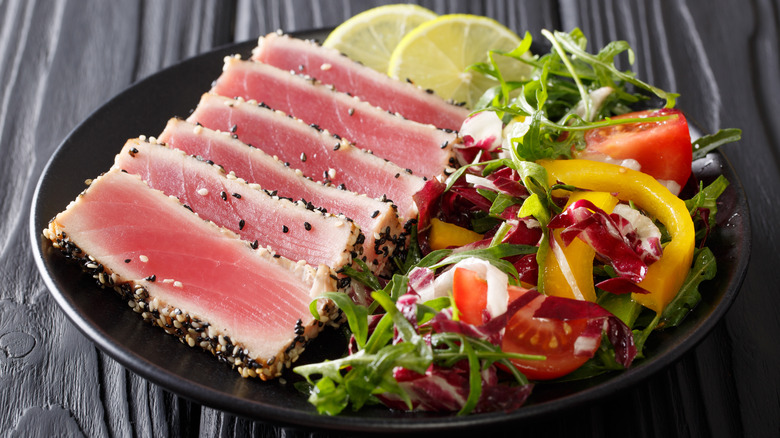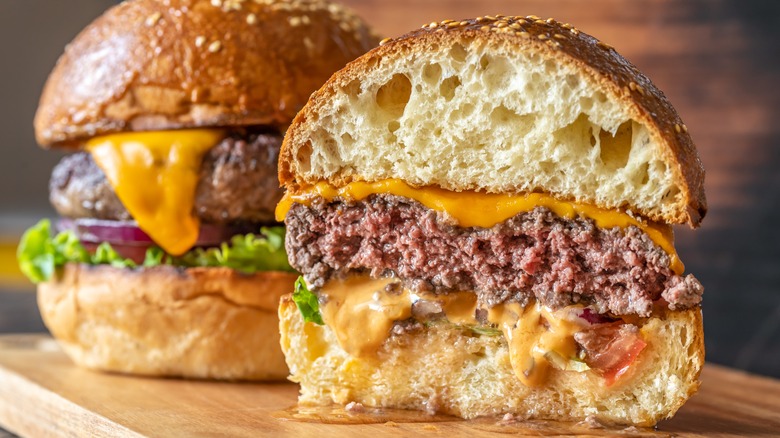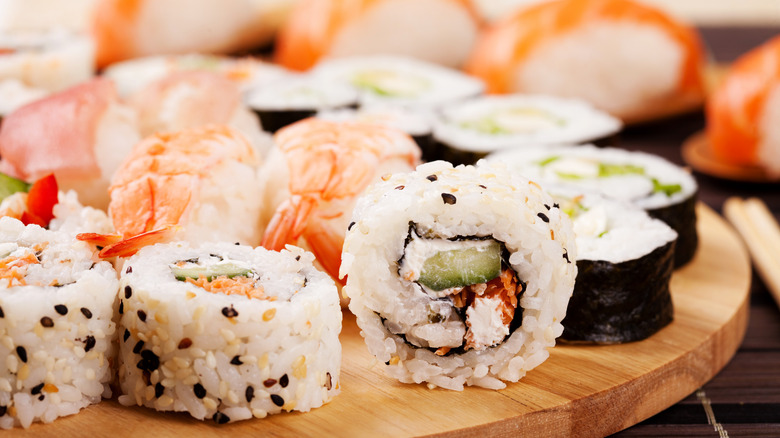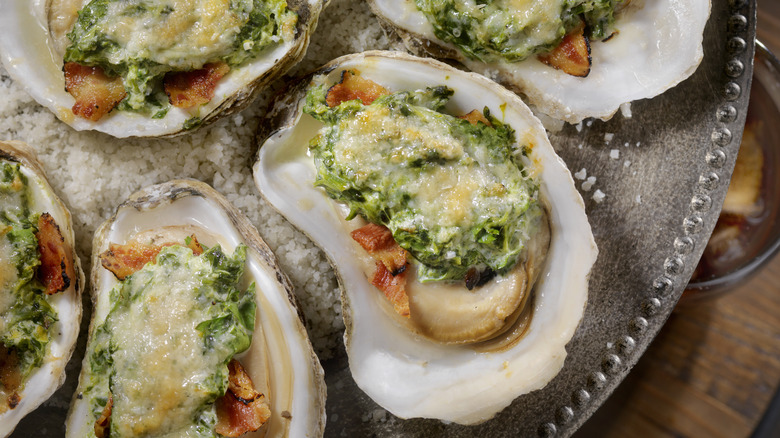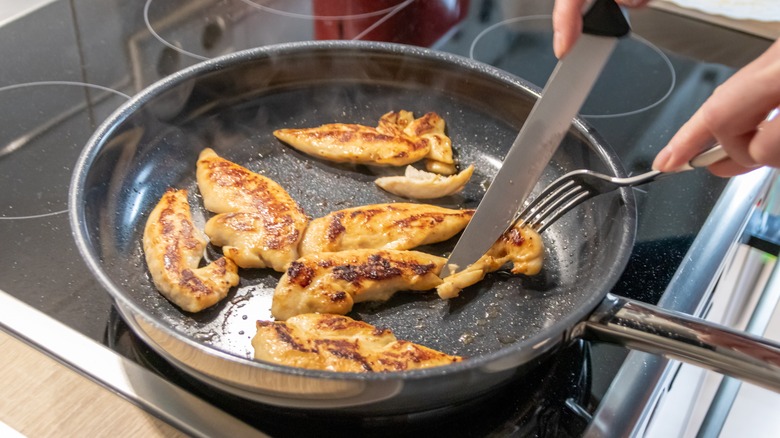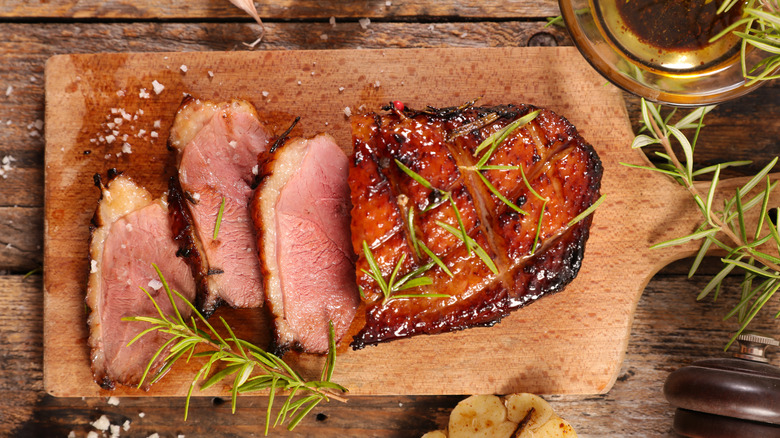Chef-Approved Tips For Cooking Meat To The Perfect Temperature
Estimates from the Centers for Disease Control and Prevention suggest that an average of 48 million Americans, or 1 in 6, will become ill from a foodborne illness, such as salmonella, campylobacter, E. coli O157:H7, or Listeria monocytogenes. Of these, 128,000 are hospitalized, and 3,000 will likely die from these illnesses. Many of these cases are linked to the consumption of undercooked animal-based protein sources.
As a chef, my job is to ensure that I know the best practices to protect my guests from potentially becoming infected by a foodborne illness. In addition to safe storage, frequent sanitization of food preparation surfaces, and good personal hygiene, the most effective way to prevent the possibility of becoming infected by a foodborne pathogen is to cook animal-based proteins to safe internal temperatures. The best way to assess the internal temperature is by using a digital or dial instant-read meat thermometer that has been calibrated.
According to USDA guidelines, each type of animal-based protein has its criteria for what is considered to be a safe internal cooking temperature. As a general rule, you should begin testing your protein near the end of cooking using a clean thermometer that has been inserted into the thickest part of the food away from bone, fat, or gristle, factoring in three minutes of "rest time" after it is removed from its heat source and continues to rise in temperature. Read on for these chef-approved tips for cooking meat to the perfect temperature while making it delicious.
Chicken, turkey, and other domesticated poultry
Chicken, turkey, and other poultry harbor salmonella bacteria within their flesh. For this reason, the USDA recommends that all poultry be cooked to a safe minimum internal temperature of 165 degrees F. Any other method of determining the safety and doneness of poultry, such as the firmness or color of its flesh or juices, is unreliable.
To ensure the temperature is accurate, insert your clean thermometer into the thickest portion of the breast or innermost part of the thigh and wing of the bird. Do note that the color of the poultry's flesh can remain pinkish even if it is fully cooked. Additionally, though duck and goose are considered to be dark meat for culinary purposes due to higher concentrations of myoglobin in their flesh, the USDA classifies them as white meat. Because of this, it recommends they be cooked to the same safe minimum internal temperature as other poultry, even if you often find it cooked to medium-rare doneness at a restaurant.
To combat your chicken becoming dry, I recommend soaking it in brine or an acidic marinade for up to an hour before cooking. You can also tenderize it by braising it in an acidic liquid, like white or red wine. Lastly, you will want to factor in carryover cooking time, as the temperature will continue to rise by approximately 5 degrees over five to 10 minutes after being removed from its heat source. To avoid overcooking with the carryover heat, it's best to pull the chicken out when it's at about 160 degrees F.
Beef, lamb, goat, and veal steaks, chops, or roasts
Though we often discuss the doneness of steaks, chops, or roasts of beef, lamb, bison, goat, and veal in terms of being rare, medium-rare, medium, or well done, the USDA considers the only safe minimum internal temperature for these animal-based proteins to be 145 degrees F. This temperature should be assessed with a clean thermometer inserted into the thickest portion of the meat before removing it from its heat source. The protein should subsequently be allowed to rest for three minutes before it is sliced and eaten.
For reference, 145 degrees F would be the equivalent of medium to medium-well doneness, which for a steak would be indicated by a hot pink center with a slightly brown periphery and a somewhat more dense texture. Science ABC notes that despite USDA guidelines, a steak prepared medium-rare at a restaurant may not be problematic. Pathogens are unlikely to permeate the exterior of a steak. Once it has been thoroughly seared, any pathogens on the surface of the meat should be destroyed, rendering the medium-rare steak safe to eat.
To minimize the possibility of a foodborne illness, you should always purchase fresh meat that has been sustainably and humanely raised and use it as soon as possible, reducing the potential of those pathogens multiplying. That said, if you are a member of a high-risk population, including young children, the elderly, pregnant women, and those who are immunocompromised, you should always avoid consuming undercooked meat.
Pork chops, steaks, and roasts
In May 20011, the USDA announced changes to its recommendations regarding the safe minimum internal temperature of pork chops, steaks, and roasts. The safe minimum internal temperature of pork was reduced from 160 to 145 degrees F, matching the guidelines for other federally inspected meats, such as beef, lamb, goat, and veal. This was done for both consistency and based on updated research regarding pathogens specific to pork, most notably trichinae.
Trichinae are parasites that can be contracted by consuming undercooked pork and wild game, which get infected by consuming other animals that host it. In the past, consuming undercooked pork could result in becoming infected with trichinosis. The USDA notes that in 1919, researchers Ransom and Benjamin Schwartz determined that trichinae were destroyed when heated to 137 degrees F and that between 1953 and 1954, states instituted laws banning feeding raw garbage to pigs, markedly reducing the number of cases of trichinosis.
Consistent with other types of meat, a safe minimum internal temperature should be determined by inserting a clean thermometer into the thickest portion of the cut before removing it from its heat source and allowing it to rest for at least three minutes. To eliminate the risk of overcooking your pork, I recommend removing it from its heat source about 5 degrees below that. Pork at this temperature will remain pink and quite juicy, which may throw off those accustomed to earlier guidelines for consuming pork cooked to 160 degrees.
Ham
Like pork, raw ham must be cooked to a safe minimum internal temperature of 145 degrees F before being removed from its heat source and allowed to rest for at least three minutes, according to the USDA. A cooked, vacuum-sealed, or canned ham that has been sourced from a purveyor that is federally inspected can be consumed as-is straight from the sealed packaging or should be reheated to a safe minimum internal temperature of 140 degrees F in an oven that has been preheated to 325 degrees or higher.
It is important to note that cooked ham sourced from a retailer that has not been federally inspected or has been repacked into a different container is not considered safe to eat unless it has been reheated to a safe minimum internal temperature of 165 degrees F as it can become contaminated once removed from its original packaging. Most holiday ham recipes involve baking the ham in the oven with a glaze to coat the exterior, making it safe to eat after cooking.
Rabbit, venison, and other game meat
Rabbit, venison, and other game meat do not fall under the purview of the Federal Meat Inspection Act (FMIA) or the Poultry Products Inspection Act (PPIA), both of which are under the jurisdiction of the USDA's Food Safety and Inspection Service (FSIS). While Congress has not mandated the inspection of these types of meat, they are voluntarily inspected by the FSIS as stated within the Agricultural Marketing Act. To guarantee these meats are free from pathogens, they must be labeled with the "Inspected for Wholesomeness by USDA" mark of inspection. Meat not voluntarily inspected by FSIS may be subject to inspection by the FDA as part of the Federal Food, Drug, and Cosmetic Act. To further complicate matters, each state has its own rules regarding the sale of these meats, and only the FDA can approve this meat for sale across state lines.
What this means for you is that following recommended safe minimum internal temperature recommendations, as established by the USDA, is crucial to ensuring these meats are safe to consume. Penn State Extension states that for rabbit, venison, and other game meat, you should cook it to 160 degrees F. Wild game bird meat should be cooked to a minimum of 165 degrees F at no less than 325 degrees F. To keep these meats tender, you may want to consider marinating them in an acid or using low, slow cooking methods that can break down dense muscle fibers and mellow out any intensely gamey flavors.
Fish and seafood
According to the Alaska Department of Health, fish and seafood are susceptible to different foodborne illnesses from land-based animals. There are two main types: ciguatera poisoning and scombroid poisoning. The former is caused by a toxin commonly found in the algae consumed by tropical fish. The latter is brought on by a bacteria that converts into a toxin in improperly refrigerated fish, resulting in an allergic reaction.
The best protection against either of these types of food poisoning is to avoid undercooked fish and seafood. According to the USDA, the safe minimum internal temperature for all fish and seafood is 145 degrees F. That said, there are plenty of instances where chefs will opt to cook these foods below the recommended temperature, such as seared ahi tuna, because of the fragility of their muscle fibers, which tend to seize up and dry out if overcooked.
Science ABC suggests this may be safer than you think since fish and seafood are typically caught and flash-frozen immediately on the boat, which usually neutralizes parasites or pathogens. The key is to purchase good quality fish or seafood and store it well. I never buy "fresh fish" unless it comes from a reputable purveyor. I always purchase frozen fish and seafood and thaw them according to the packaging directions before cooking them. While minimal risk may still be involved, I feel confident serving properly handled fish and seafood below USDA recommendations for the safe minimum internal temperature to those not members of a high-risk population.
Ground meat
One topic discussed more than any other during the certification process for obtaining the Food Handlers License required by employees of food service establishments is the safety of ground meat. As noted by Consumer Reports, ground meat is the single most common culprit of foodborne illness due to myriad factors, ranging from how animals are raised in concentrated animal feeding operations to how they are slaughtered and eventually processed for sale and consumption.
Indeed, animals harboring pathogens sent to slaughter can easily contaminate the meat of other animals. And since most packages of ground meat contain the flesh of multiple animals and are processed on machinery that is not always sanitized between batches, pathogens can quickly spread like wildfire. For this reason, the USDA recommends that all ground meat, except poultry, be cooked to a safe minimum internal temperature of 160 degrees F. Ground poultry must be cooked to 165 degrees F.
As a chef, I feel perfectly safe cooking a medium-rare steak, but I never cook ground meat below the safe minimum internal temperature suggested by the USDA. If you have concerns regarding ground meat drying out during cooking, purchase meat with a lean-to-fat ratio of no lower than 85/15. You should also add moisture to your meatloaf, burgers, or meatballs using liquid or sautéed vegetables. Lastly, you can sprinkle your ground beef with baking soda and let it sit for 15 minutes before using it to help retain moisture.
Sushi
Sushi represents a dilemma in many ways. It is a tradition whose modern iteration involving the consumption of raw fish with rice evolved in Japan during the 17th century. Its production has been elevated into something akin to an art form, and consumption enjoys tremendous popularity in the U.S. Despite its lengthy history and popularity, its safety can be questionable.
As Webstaurant Store notes, while many sushi purveyors claim they only use "sushi grade fish," this designation is unregulated. It is more of a marketing ploy than a guarantee of eating safe fish. The only official sushi safety guideline for fish is the FDA protocol known as the "Parasite Destruction Guarantee." These are specifications for the storage and freezing of individual species of fish at extremely low temperatures for several hours to destroy any parasites that may be present.
As the Cleveland Clinic notes, despite safety concerns, those not members of high-risk populations can confidently consume sushi under the right circumstances. Choosing a sushi restaurant with consistent reviews is always a good bet, as is opting for saltwater fish versus freshwater fish. You may want to avoid purchasing sushi from a gas station, grocery store, or other retailer not well equipped to freeze and store their fish and seafood properly. If you are still concerned, opt for sushi made from cooked fish and seafood, such as crab, shrimp, and eel.
Raw oysters
Raw oysters are another delicacy that may pose risks if consumed. The Centers for Disease Control and Prevention notes that they are particularly susceptible to harboring Vibrio bacteria, which inhabit the coastal waters these mollusks call home. Oysters ingest these bacteria as they filter water to feed, causing them to condense within their flesh. If consumed raw, these bacteria can cause the foodborne illness vibriosis.
Vibriosis affects approximately 80,000 people and causes around 100 deaths annually. Contrary to myriad myths ranging from avoiding raw oysters in months ending in the letter "r" to dousing them in hot sauce or alcohol, the only surefire way to destroy Vibrio bacteria is to cook them before consuming them. Shellfish should not be consumed if they do not fully open after cooking. Oysters must be cooked after shucking by boiling, frying, or broiling them for three minutes or baking them at 450 degrees F for 10 minutes.
While anyone can get vibriosis from either consuming or handling raw oysters with an open wound, some populations are more at risk of serious complications, including the elderly, young children, pregnant or lactating women, and those who are immunocompromised. Individuals with liver disease, cancer, diabetes, HIV, or the blood disorder thalassemia, or those taking medication to manage stomach acid are also at an elevated risk for severe illness.
Leftover meat
Once meat has been cooked to its initial safe minimum internal temperature, it should be consumed or refrigerated within two hours. The USDA calls this the "2-Hour Rule." Foods left in the Danger Zone, between 40 and 140 degrees F, are at considerably higher risk of becoming contaminated by bacteria and causing foodborne illness.
Leftover meat of any kind must be reheated to 165 degrees F. This can be done on the stovetop, in a microwave, or baked in an oven that's been preheated to 325 degrees F or higher. It is never advisable to reheat leftover meat in a crock pot or slow cooker where it can remain in the Danger Zone for a lengthy period. Adding moisture to the pan, such as water, stock, or wine, can help keep your meat tender as it reheats.
While leftover meat may not have the taste or texture it did when freshly cooked, flex your creative muscles and repurpose it. My favorite ways to reuse leftover meats are to add them to a breakfast frittata, quiche, or strata, pop them into a stew or soup, or turn them into nachos or tacos. Other ingredients, like vegetables, eggs, and cheese, can help revive your meat and infuse it with extra flavor and juiciness.
Doneness versus safety
If you are preparing a steak and read the instructions for the recipe, the meat will likely be considered ready to eat when it is cooked to medium-rare. This level of doneness is the temperature most chefs believe to be ideal for the best flavor and texture of cuts of beef. The temperature range for medium-rare meat is between 130 and 135 degrees F. The safe minimum internal temperature for a beef steak, as noted by the USDA, is 145 degrees F.
As I have already noted, there are instances where what chefs consider edible and delicious is at odds with what USDA guidelines indicate. Chefs have the complicated task of producing food that tastes as good as can and is safe for diners to eat. Occasionally, this means disregarding USDA guidelines instead of the longstanding tradition and experience of professional chefs who have meticulously studied the best practices for cooking myriad foods to perfection.
When this discrepancy occurs, you will always find a consumer advisory on the menu consisting of both a disclosure and a reminder. These are intended to identify foods that may not be prepared to a safe minimum internal temperature and include the following verbiage: "Consuming raw or undercooked meats, poultry, seafood, shellfish, or eggs may increase your risk for foodborne illness; especially if you have a medical condition." These advisories place the onus on the consumer to make an informed decision as to whether or not the risks outweigh the payoff.
